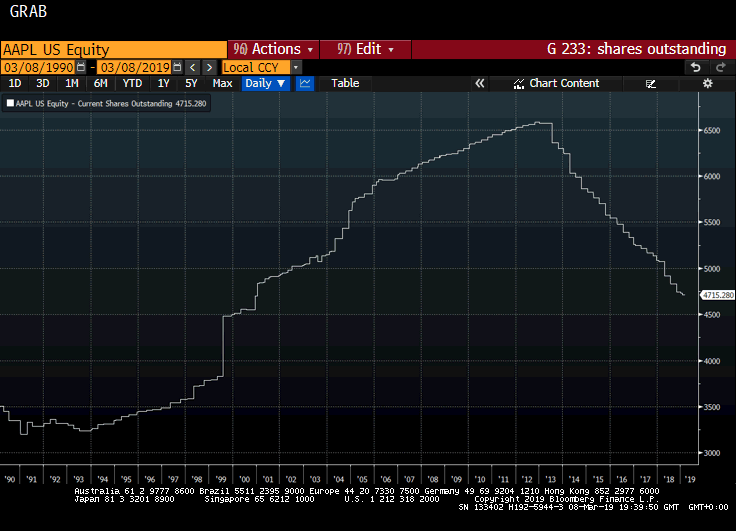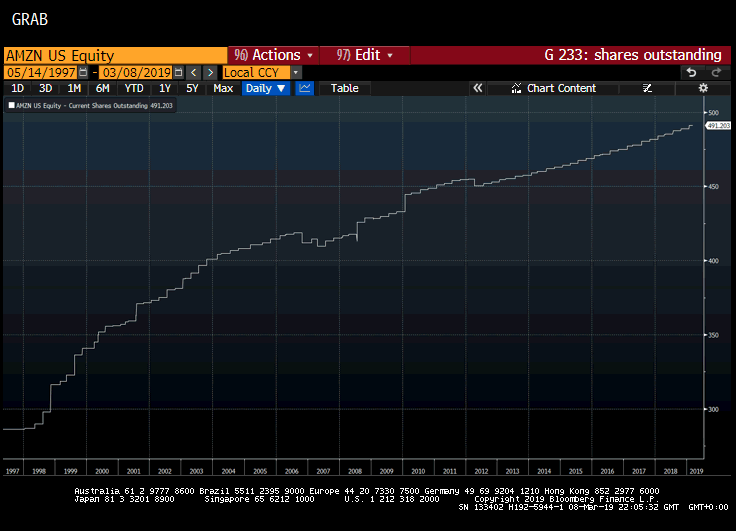An 80 Billion-Share Mystery Surrounds Buybacks
This article by Stephen Gandel for Bloomberg may be of interest to subscribers. Here is a section:
Yardeni says the companies in the S&P 500 have spent roughly $4.5 trillion on buybacks over the past 10 years, yet by his calculation, which include some adjustments, the shares outstanding of those companies has dropped by just 2 percent during that time. What accounts for the difference? Employee stock compensation.
Buybacks haven’t returned cash to shareholders, or boosted share prices, Yardeni says. All they have done is bought back the shares that have been issued to employees, essentially enabling higher executive compensation by picking up the tab of stock options. Based on data from S&P Dow Jones Indices, the current members of the S&P 500 had 284 billion shares outstanding in early 2009, and have bought back bought 81.5 billion shares through the end of 2018. That means shares outstanding should have dropped by nearly 29 percent, instead of falling 2 percent, by Yardeni’s calculations – or rising
slightly, as data from S&P show.
Even after accounting for equity issuance and share-count changes due to acquisitions, I calculate that roughly two-thirds of what companies spent on buybacks appears to have gone toward offsetting executive compensation. And there’s more to the story.
The tale usually told about buybacks is that companies have this pot of profits and they are choosing to use it to prop up their stock with buybacks. But back in 2005, the Financial Standards Accounting Board began forcing companies to expense the cost of option grants, even though they aren’t a cash
outlay. That means buybacks aren’t really funding stock grants. Corporate bottom lines already include the cost of stock options. By the time you get to the bottom line, that money has effectively already been “spent.”Repurchases are just a way of squaring that accounting. Without buybacks, shareholders would effectively be paying for stock compensation twice – once when they are expensed and a second time from the dilution of additional shares. Executives get the options either way. And indeed, the growth of buybacks in the past decade-and-a-half correlates pretty closely with the 2005 accounting change for options. There is even some research to suggest causation.
We are about 18 months out from the next US Presidential Election and positions are being staked out. So far, we have seen some quarters on the progressive left support modern monetary theory and many from the financial community decrying the suite of policies as sacrilegious. We have heard calls for free healthcare for all and simple questions about how it is going to be paid for. We have seen calls for big companies like Amazon and Facebook to be broken up. Where there has been clear evidence of cross-party support has been to either tax or reduce buybacks. That suggests it is going to be an election issue which has potential to be enacted.
Getting reliable data for the numbers of shares outstanding is quite difficult and it is not tickerised on Bloomberg so we cannot import the data into the Chart Library. I created this chart in 2013 because I was curious about the role buybacks and delistings were having on the total supply for shares.
It can best be described as a quasi-measure because I had to impute the data from two different indices., It takes the NYSE short interest and divides it by the short interest as a percentage of total shares outstanding. Its pattern confirms that the total number of shares outstanding is higher than the level that prevailed for the decade up to 2013.
If the view that $4.5 trillion has been funneled into the pockets of senior employees at US corporations, at a time when the average worker has seen paltry wage hikes, gains traction it is going to represent a significant challenge for the market.
The simple fact of the matter is the market is accustomed to buybacks regardless of whether they have resulted in a net withdrawal of shares or not. Without buybacks, executives will need to be paid less to offset the dilatative effect of stock options. That is likely to be a very contentious discussion. Buybacks have been one of the primary avenues through which monetary and fiscal largesse have found their way into the stock market so any significant change to the status quo is likely to have a meaningful effect on the market.
Meanwhile one of the reasons investors have been happy to support buybacks is because they believed that the shares remaining were therefore representative of a greater share of the company. That is certainly a view I had sympathy with and it is has also been espoused by Warren Buffett. The above data suggests the reality is very much more nuanced.




For example, IBM has indeed been reducing the number of shares outstanding. Apple’s number of shares outstanding is back where it was in 2000 but Amazon’s supply of shares is still trending higher while Facebook’s remains unchanged since 2013. These differences make the case for looking at charts of the historical progression of market cap more compelling particularly in the rare cases where divergences occur.


